Structural Properties
RSM
Rapid Reciprocal Space Mapping of Thin Films
The structural properties of epitaxial multilayer coatings are of paramount importance for the functionality of devices in semiconductors, optoelectronics, ferroelectrics and spintronics. Reciprocal Space Mapping (RSM) with XRD has become the de facto technique to characterize the structure of thin crystalline layers. By RSM, both perpendicular and lateral strain, composition and domain effects are determined non-destructively. With RapidRSM, the diffracted intensity is measured with a 1D detector which is actively read out as the scan is performed, leading to a dramatic reduction in scan time to just a few minutes or even seconds.
IPGID
In Plane Reciprocal Space Mapping
Conventional aka coplanar X-ray Diffraction probes distances which are perpendicular to the surface of a sample. This means that properties including relative orientation of domains and in-plane lattice parameter can essentially only be assumed. With a non-coplanar detector arm, the D8 DISCOVER Plus is able to directly measure film properties in the surface plane of the sample.
Stress
Investigation of a polycrystalline tungsten coating on silicon
Many processing steps leave residual stresses which can affect the performance of manufactured components. Compressive stress can be engineered into a metal coating to resist crack propagation, while tensile stress can be exploited to enhance conductivity in semiconductors. Strained materials exhibit changes in atomic spacing which can be detected by X-ray diffraction (XRD) and related to the stress via elastic constants.

